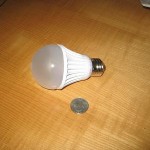Energy Star Exempts ‘snow-cone’ LED bulbs from certification program!
 In a surprise move, Energy Star says that it plans to remove “non-standard lamps” from the Energy Star Integral LED Lamps specification. Specifically the low cost “Snow Cone” style bulbs are being exempted. Many in the industry fear this will lead to lower quality, inferior products that may hurt the consumer image of LED lighting in general.
In a surprise move, Energy Star says that it plans to remove “non-standard lamps” from the Energy Star Integral LED Lamps specification. Specifically the low cost “Snow Cone” style bulbs are being exempted. Many in the industry fear this will lead to lower quality, inferior products that may hurt the consumer image of LED lighting in general.
Why the sudden move? Just a guess from myself, perhaps the EPA is realizing that the CFL bulb replacements for incandescents are somewhat of a BIG MISTAKE considering they use small amounts of mercury vapor AND the horrid effect they have on the nation’s power grid due to their inherently LOW power factor. Perhaps the lesser of evils, the EPA wants cheap low quality LED bulbs to displace cheap low quality CFL’s!!
November 15, 2010
Dear ENERGY STAR® Integral LED Lamp Partner or Interested Party:
The U.S. Environmental Protection Agency (EPA) has identified provisions included in the ENERGY STAR Integral LED Lamps specification which could allow for qualification of lamps which fail to meet consumer expectations. The purpose of this letter is to notify you that after careful review and consideration, EPA intends to remove section 6, “Non-Standard Lamps”, from the ENERGY STAR Integral LED Lamps specification, effective immediately.
Solid state lighting, like other energy efficient lighting technologies, has great potential to help American consumers and businesses save energy and save money, while helping to protect the environment. As the technology continues to mature, EPA, the Department of Energy and ENERGY STAR partners and stakeholders have discussed at length the necessity of ensuring positive consumer experiences with solid state lighting products, avoiding the problems associated with early compact fluorescent lamps. It is of the utmost importance that consumers find ENERGY STAR qualified integral LED lamps to be proper replacements for their existing lamps, providing not only greater energy efficiency but also photometric performance which meets or exceeds that of the lamp they are replacing.
The Integral LED Lamps specification contains provisions for standard lamps, with photometric requirements for ANSI-standardized omnidirectional, reflector, and decorative lamp shapes, and provisions for “non-standard” lamps with fewer technical requirements, originally included in the specification to allow for innovative lamp designs that do not conform to ANSI standards. Recently, products have been presented to the Agency that visually appeared to match an ANSI standard lamp shape but failed to meet the photometric performance requirements for that shape, and therefore were not eligible for qualification as standard lamps. Subsequently, these products were presented for qualification as non-standard lamps.
This approach of using the non-standard category as an alternate means of qualification defeats the purpose of the non-standard category, and constitutes a potential loophole which threatens to undermine the meaning of the ENERGY STAR in this product category. The Agency recognizes that consumers are accustomed to employing standard lamp shapes in their homes and businesses, and have an established understanding of what performance to expect from those shapes. Further, the Agency is concerned that LED lamps exhibiting standard shapes but not meeting performance requirements set for those shapes (in section 7 and 7A) will disappoint consumers whose expectations are set in large part by physical similarities. In the worst case scenario, these disappointed consumers would relate their negative experience with ENERGY STAR, and with LEDs.
To ensure a positive consumer experience with ENERGY STAR qualified integral LED lamps, EPA intends to remove provisions for non-standard lamps from the Integral LED Lamps specification. This change will be included in version 1.2 of the specification which, in support of the Program’s enhanced testing and verification requirements, is scheduled to replace version 1.1 as of January 1, 2011. Comments on this action may be submitted to ssl@energystar.gov by December 6, 2010.
The Agency also recognizes that solid state lighting technologies, including LEDs, present an opportunity to reconsider the form factors of lighting products commonly employed by consumers and businesses, and will therefore continue to monitor innovative product design. EPA will consider how such products could be included in the scope of the ENERGY STAR Lamps specification currently in development to become effective in 2012, and what requirements would be necessary to avoid negative consumer experiences.
Please feel free to contact me with questions at baker.alex@epa.gov, or (202) 343-9272. Thank you for your support of ENERGY STAR.
Sincerely,
Alex Baker
Lighting Program Manager, ENERGY STAR
US EPA





